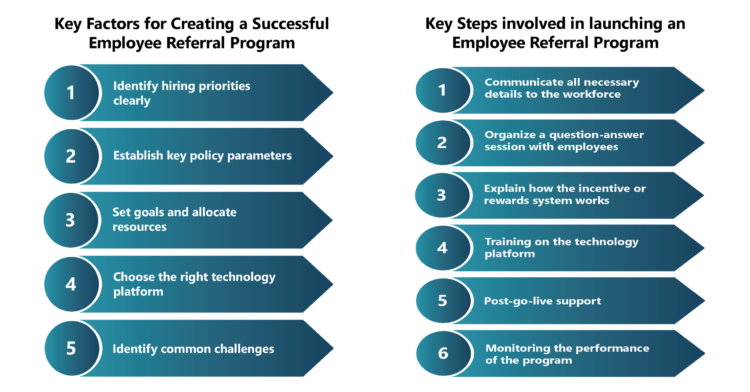1. Enhance Recruitment Efficiency: Employee referral programs reduce hiring costs and time, improve the quality of hires, and increase employee retention, contributing to higher productivity.
2. Empower and Motivate Employees: These programs empower and motivate employees by allowing them to contribute to recruitment. This provides a sense of ownership, pride, and potential rewards, which boosts motivation and engagement.
3. Strategic Planning: Successful programs need clear hiring priorities, well-defined policies, measurable goals, the right technology platform, and continuous monitoring to maintain effectiveness.
4. Effective Launch and Support: Launching the program with comprehensive communication, training, and ongoing support ensures employee participation and program transparency, leading to its long-term success.
Most organizations leverage several channels for talent acquisition for their staffing needs. One channel of talent acquisition that is becoming increasingly popular with many organizations is implementing an employee referral program. Hence, organizations must set up employee referral programs to deliver the desired results.

Employee referral programs enable employees to refer candidates from their personal or professional networks for job openings in their organizations.
When happy and satisfied, employees feel naturally inclined to share their experiences in their professional and personal networks.
According to a report by SilkRoad, employee referrals resulted in more than 30% of all recruitment and 45% of internal hires. This report was based on an analysis of the data collected from 14 million applications and 329,000 hires.

This talent acquisition strategy proves beneficial for both participating employees and the hiring organization in the following ways:
1. It gives employees a sense of empowerment and ownership by being able to contribute to the organization beyond their work.
2. Most organizations offer rewards or incentives to employees by providing referrals for various job positions, further enhancing their motivation.
3. Providing job opportunities to others increases their sense of pride and stature in their networks.
Given the advantages of an employee referral program, organizations need to set up the program with its policies and processes.
So, here are the factors that organizations need to consider to create a successful employee referral program:


Organizations need to establish their hiring priorities.
To start with, they should list out the open positions for referrals and the rewards or incentives for each position.
Establishing clear hiring priorities makes it easier for organizations to create the proper framework for the referral program.

The employee referral program should inform employees about how it would work and why they should participate.
Employees should get a clear understanding of the guidelines for submitting referrals and the criteria for getting incentives for referrals.

Setting measurable, specific, and timed objectives is essential to establishing a successful employee referral program.
It is also essential to allocate the proper budget and resources to ensure the fulfillment of these goals.
Moreover, organizations need to ensure that the employees are aware of these objectives before the program is launched.
This will give them a good understanding of how their referrals can help the organization.

The success of an employee referral program also depends on the technology platform used by the organization. The platform should be easy to use and engaging.
It should provide comprehensive details such as the available positions, job descriptions, the skills and experience required, and referral incentives.
The platform should also allow easy integration with various social media channels.
Hence, this would make it easier for the employees to spread the word across their professional and social networks.
Most importantly, the system should enable the employees to submit referrals and track their status.

Implementing an employee referral program is fraught with challenges.
Identifying the challenges upfront makes the organizations better prepared to handle them as and when they arise.
These common challenges include maximizing employee participation, reinforcing the process’s fairness, and maintaining the program’s novelty and excitement.

1. Employee referral programs help organizations cut down on hiring costs and time even after considering the incentives to the employees.
2. Those hired through employee referrals tend to have a higher chance of matching the job needs, resulting in higher productivity.
3. Employees hired through employee referrals are likelier to stay longer and contribute more to the organization.

How an employee referral program is launched can set the stage for success or failure.
Hence, organizations need to create a buzz around the launch to make the occasion special and memorable.
Additionally, organizations need to consider the following to ensure a successful launch of the program:

Organizations need to ensure that the workforce members are provided with complete details of the referral program.
Hence, it is advisable to create a detailed presentation covering all these details. It can be shared digitally or otherwise with the employees during the program launch.
The presentation should also use text, audio, and visuals to help employees quickly understand the program’s functions and benefits.

Organizing a question-answer session is another crucial aspect of launching an employee referral program.
The session enables the employees to understand the nuances of the program including the objectives, the policy, and the process.
Also, it enables the organization to address basic queries and concerns that employees may have about the program.

Employees are generally incentivized for candidates hired through their referrals.
Details of how the referral rewards system works should be part of the launch communication.
Also, to encourage more participation, organizations can consider offering a small bonus or reward to every employee who submits a referral.
Subsequently, the policy can be modified to reward only referrals that result in the successful hiring of candidates.

Another critical aspect is providing proper employee training for using the technology platform.
This could be done through live in-person or digital training sessions.
These training sessions should cover the various steps involved in the submitting and processing of the referrals.

Additionally, the organization should provide support through an email or chat helpdesk, a list of frequently asked questions, and detailed process documentation.
Also, any policy or process updates should be shared immediately to ensure complete transparency of the program.

Monitoring the program’s performance and impact is also critical to its success.
This includes assessing the quality of hires, the recruitment costs and time, and the impact on the workplace culture through the referral program.
Hence, this would help improve the program and ensure better quality and quantity of candidates recruited through this channel.
A well-developed successfully launched and efficiently managed employee referral program can help organizations gain easy access to a vast and untapped talent pool of potential candidates and hire them faster and at a lower cost.

Lead author: Sagar Chaudhuri, the Co-Founder and CEO of HiFives. He is an HR Tech Evangelist with over 25 years of experience in both corporate and entrepreneurial settings. Previously, Sagar has held leadership roles with companies such as Genpact, Infosys, and ICICI Bank. He has an engineering degree from IIT Kharagpur and an MBA from IIM Lucknow. Connect on LinkedIn
To stay updated on the latest HiFives blogs, follow us on Twitter (@MyHiFives)